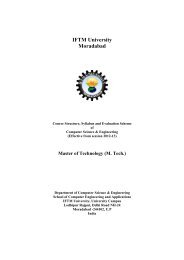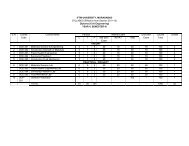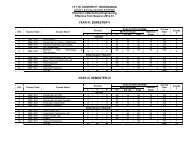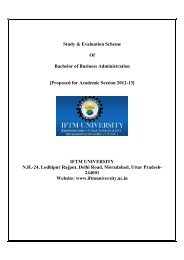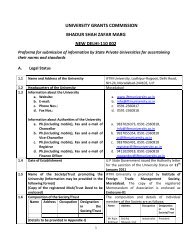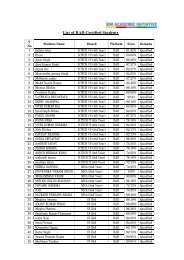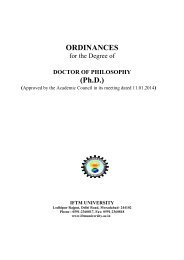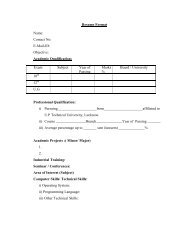Study & Evaluation Scheme Of Bachelor of ... - IFTM University
Study & Evaluation Scheme Of Bachelor of ... - IFTM University
Study & Evaluation Scheme Of Bachelor of ... - IFTM University
You also want an ePaper? Increase the reach of your titles
YUMPU automatically turns print PDFs into web optimized ePapers that Google loves.
<strong>Study</strong> & <strong>Evaluation</strong> <strong>Scheme</strong><br />
<strong>Of</strong><br />
<strong>Bachelor</strong> <strong>of</strong> Commerce<br />
(Honours)<br />
[Proposed for Academic Session 2012-13]<br />
<strong>IFTM</strong> UNIVERSITY<br />
N.H.-24, Lodhipur Rajput, Delhi Road, Moradabad, Uttar Pradesh-244001<br />
Website: www.iftmuniversity.ac.in
<strong>IFTM</strong> UNIVERSITY<br />
N.H.-24, Lodhipur Rajput, Delhi Road, Moradabad, Uttar Pradesh-244001<br />
Website: www.iftmuniversity.ac.in<br />
<strong>Study</strong> & <strong>Evaluation</strong> <strong>Scheme</strong> <strong>Of</strong><br />
<strong>Bachelor</strong> <strong>of</strong> Commerce (Honours)<br />
[Proposed for Academic Session 2012-13]<br />
Summary<br />
Programme:<br />
<strong>Bachelor</strong> <strong>of</strong> Commerce (Honours)<br />
Course Level:<br />
Degree (Unger Graduate)<br />
Duration:<br />
Two years (six semesters) Full Time<br />
Medium <strong>of</strong> Instruction:<br />
English<br />
Minimum Required Attendance 75%<br />
Maximum Credits 146
<strong>Study</strong> and <strong>Evaluation</strong> <strong>Scheme</strong><br />
Programme : B.COM. (HONS.)<br />
SEMESTER I<br />
S. Paper code Subject title Period Credit <strong>Evaluation</strong> <strong>Scheme</strong><br />
No<br />
L T P<br />
Internal External<br />
Total<br />
1 B.Com 101 Accounting and Financial 4 -- -- 4 30 70 100<br />
Analysis<br />
2 B.Com 102 Principles and Practices <strong>Of</strong> 4 -- -- 4 30 70 100<br />
Management<br />
3 B.Com 103 Micro Economics 4 -- -- 4 30 70 100<br />
4 B.Com 104 Business Mathematics 4 -- -- 4 30 70 100<br />
5 B.Com 105 Business Communication 4 -- -- 4 30 70 100<br />
6 B.Com 106 Legal Aspects <strong>of</strong> Business 4 -- -- 4 30 70 100<br />
Total 24 -- -- 24 180 420 600<br />
SEMESTER II<br />
S. Paper code Subject title Period Credit <strong>Evaluation</strong> <strong>Scheme</strong><br />
No<br />
L T P<br />
Internal External<br />
Total<br />
1 B.Com 201 Business Statistics 4 -- -- 4 30 70 100<br />
2 B.Com 202 Macro Economics 4 -- -- 4 30 70 100<br />
-<br />
3 B.Com 203 Business Environment 4 -- -- 4 30 70 100<br />
4 B.Com 204 Fundamentals <strong>of</strong> Computers 4 -- -- 4 30 70 100<br />
5 B.Com 205 Corporate Accounting 4 -- -- 4 30 70 100<br />
6 B.Com 206 Marketing Management 4 -- -- 4 30 70 100<br />
Total 24 -- -- 24 180 420 600
SEMESTER III<br />
S. Paper code Subject title Period Credit <strong>Evaluation</strong> <strong>Scheme</strong><br />
No<br />
L T P<br />
Internal External<br />
Total<br />
1 B.Com 301 Advanced Accounting and 3 -- 1 4 30 70 100<br />
Audting<br />
2 B.Com 302 Operations Research 4 -- -- 4 30 70 100<br />
3 B.Com 303 Human Resource Management 4 -- -- 4 30 70 100<br />
4 B.Com 304 E-Commerce 4 -- -- 4 30 70 100<br />
5 B.Com 305 Company Law 4 -- -- 4 30 70 100<br />
6 B.Com 306 Organisational Behaviour 4 -- -- 4 30 70 100<br />
Total 23 -- 1 24 180 420 600
SEMESTER IV<br />
S. Paper<br />
Subject title<br />
Period Credit <strong>Evaluation</strong> <strong>Scheme</strong><br />
No code<br />
.<br />
L T P<br />
Internal External<br />
Total<br />
1 B.Com 401 Banking and Insurance system 4 -- -- 4 30 70 100<br />
in India<br />
2 B.Com 402 Indian Economic Environment 4 -- -- 4 30 70 100<br />
3 B.Com 403 Productions and Operations 4 -- -- 4 30 70 100<br />
Management<br />
4 B.Com 404 Entrepreneurship Development 4 -- -- 4 30 70 100<br />
5 B.Com 405 Management Information 4 -- -- 4 30 70 100<br />
System<br />
6 B.Com 406 Financial Management 4 -- -- 4 30 70 100<br />
Total 24 -- -- 24 180 420 600<br />
Note:<br />
L- Lecture 1L=1Hr.<br />
T-Tutorial 1T=1Hr.<br />
P-Practical 1P=1Hr.<br />
C-Credits 1C=1Hr. <strong>of</strong> Theory Paper<br />
=1Hr. <strong>of</strong> Practical/Tutorial<br />
*Summer Training 4-6 weeks
<strong>IFTM</strong> <strong>University</strong>, Moradabad<br />
<strong>Bachelor</strong> <strong>of</strong> Commerce (B.Com Hons.) Programme<br />
BCOM 101: ACCOUNTING AND FINANCIAL ANALYSIS Max. Hours: 40<br />
UNIT I. Introduction :<br />
Nature <strong>of</strong> Accounting, Accounting as an information system and language <strong>of</strong> business, Basic<br />
Concepts and Conventions, Changing role <strong>of</strong> accountant in pr<strong>of</strong>ession and Industry, Financial<br />
accounting standards.<br />
UNIT II Double Entry System:<br />
Maintenance <strong>of</strong> different books <strong>of</strong> accounts, Journal and its sub-division, Ledger and its subdivision,<br />
Journal Proper, Cash Book.<br />
UNIT III. Final Accounts<br />
Preparation <strong>of</strong> Final Accounts & Balance Sheet (other than corporate bodies): Preparation <strong>of</strong><br />
Trial Balance, Closing and adjustment entries through Journal, Provision for depreciation<br />
(different methods), Provision for Bad and Doubtful Debts, Creation <strong>of</strong> Reserves-general,<br />
specific, revenue, capital & secret., Drawing <strong>of</strong> Manufacturing Account, Trading Account, Pr<strong>of</strong>it<br />
and Loss Account and Pr<strong>of</strong>it and Loss Appropriation Account, Preparation <strong>of</strong> Balance Sheet.<br />
UNIT IV Analysis <strong>of</strong> financial statements<br />
Ratio Analysis- solvency ratios, pr<strong>of</strong>itability ratios, activity ratios, liquidity ratios, market<br />
capitalization ratios ; Common Size Statement ; Comparative Balance Sheet and Trend Analysis<br />
<strong>of</strong> manufacturing, service & banking organizations.<br />
Suggested Readings:<br />
1. Jain S.P.and Narang K.L.-Advanced Accounting<br />
2. Maheshwari S.N. and Maheshwari S.K. Fundamental <strong>of</strong> Accounting<br />
3. Chowdhry Anil Fundamentals <strong>of</strong> Accounting & Financial Analysis
<strong>IFTM</strong> <strong>University</strong>, Moradabad<br />
<strong>Bachelor</strong> <strong>of</strong> Commerce (B.Com Hons.) Programme<br />
BCOM: 102 N PRINCIPLES AND PRACTICES OF MANAGEMENT Max. Hours: 40<br />
UNIT – I<br />
Management: Introduction - Meaning, nature and characteristics <strong>of</strong> Management - Scope and<br />
functional areas <strong>of</strong> management - Management as a science art or pr<strong>of</strong>ession - Development <strong>of</strong><br />
Management Thought: Classical, Neo-classical, Systems, Contingency and Contemporary<br />
Approach to Management – Drucker, Porter, Senge, Prahalad, Hammer, and Tom Peters.<br />
UNIT – II<br />
Planning: Nature, importance and purpose <strong>of</strong> planning - Planning process, Objectives - Types <strong>of</strong><br />
plans (Meaning only) - Decision making – importance & steps.<br />
UNIT – III<br />
Organising and Staffing : Nature and purpose <strong>of</strong> organisation, Principles <strong>of</strong> organisation -<br />
Types <strong>of</strong> organization - Departmentation, Committees - Centralisation Vs decentralisation <strong>of</strong><br />
authority and responsibility - Span <strong>of</strong> Control - MBO , Nature and importance <strong>of</strong> staffing -<br />
Process <strong>of</strong> selection & recruitment(in brief).<br />
UNIT – IV<br />
Directing: Meaning and nature <strong>of</strong> directing - Leadership styles - Motivation theories (Maslow’s,<br />
Herzberg, McGregors X & Y theory) - Communication meaning and importance, barriers to<br />
communication, types <strong>of</strong> communication<br />
Controlling: Meaning and steps in controlling - Essentials <strong>of</strong> a sound control system - Methods<br />
<strong>of</strong> establishing control( in brief).<br />
Suggested Readings:<br />
1. Koontz & O’Donnell, Management.<br />
2. Appaniah & Reddy, Essentials <strong>of</strong> Management.<br />
3. L M Prasad, Principles <strong>of</strong> management.<br />
4. Srinivasan & Chunawalla, Management Principles and Practice.<br />
5. S V S Murthy, Essentials <strong>of</strong> Management.<br />
6. Thomas. N. Duening & John. M. Ivan cevich, Management, Principles and Guidelines,<br />
Biztantra Publications.
<strong>IFTM</strong> <strong>University</strong>, Moradabad<br />
<strong>Bachelor</strong> <strong>of</strong> Commerce (B.Com Hons.) Programme<br />
BCOM: 103: MICRO ECONOMICS Max. Hours: 40<br />
UNIT I<br />
Introduction To Economics: Meaning, Nature and Scope <strong>of</strong> Business Economics – Micro and<br />
Macro, Economic Activities, utility concept; Basic Economic Problems, Production Possibility<br />
Curve; Market forces in solving economic problems.<br />
UNIT II<br />
Demand & Supply Analysis: Meaning, Types <strong>of</strong> Demand, demand Schedule, Demand curve,<br />
Law <strong>of</strong> Demand; Determinants & Exceptions; Elasticity <strong>of</strong> Demand and their types; Concept and<br />
Law <strong>of</strong> Supply; Factors Affecting Supply, Elasticity <strong>of</strong> Supply<br />
UNIT III<br />
Cost & Revenue Analysis: Accounting Costs and Economic Costs; Short Run Cost Analysis:<br />
Fixed, Variable and Total Cost Curves, Average and Marginal Costs; Long Run Cost Analysis:<br />
Economies and Diseconomies <strong>of</strong> Scale and Long Run Total, Average and Marginal Cost Curves;<br />
Concept <strong>of</strong> Revenue .Total, Marginal, Average revenue; Revenue & Cost Curves under different<br />
Market Conditions<br />
UNIT IV<br />
Pricing Under Various Market Conditions: Price and Output Determination under different<br />
Market Conditions: Perfect Competition Monopoly, Monopolistic Competition<br />
Suggested Readings:<br />
1. Dwivedi, D N, Managerial Economics, Vikas Publishing House, New Delhi.<br />
2. Mehta, P L, Managerial Economics, S. Chand , New Delhi, 2007.<br />
3. Chaturvedi, D D, & Gupta, S L, Business Economics, Brijwasi Publishers. (2006)<br />
4. Koutsoyiannis, A., Modern Micro Economics, Macmillan Press Ltd, 2006<br />
5. Salvator, Dominick, Managerial Economic, McGraw – Hill Book Company,2002
<strong>IFTM</strong> <strong>University</strong>, Moradabad<br />
<strong>Bachelor</strong> <strong>of</strong> Commerce (B.Com Hons.) Programme<br />
BCOM: 104 BUSINESS MATHEMATICS ` Max. Hours: 40<br />
UNIT I<br />
Matrix: Introduction, Square Matrix, Column Matrix, Diagonal Matrix, Identity Matrix,<br />
Elementary operations on matrices: Addition, Subtraction & Multiplication; Minors and<br />
C<strong>of</strong>actors <strong>of</strong> the elements <strong>of</strong> a determinant, Adjoint <strong>of</strong> a square matrix, Inverse <strong>of</strong> a Matrix,<br />
UNIT II<br />
Types <strong>of</strong> data and representation(graphic/diagrams), measures <strong>of</strong> central tendency: mean, median<br />
& mode.<br />
UNIT III<br />
Systems <strong>of</strong> linear equations, Consistency <strong>of</strong> equations: Testing the consistency <strong>of</strong> equations by<br />
rank method; Solution <strong>of</strong> linear equations: Matrix method and Cramer’s rule<br />
UNIT IV<br />
Concept <strong>of</strong> Differentiation and Integration, Maxima and Minima in Differentiation; Application<br />
<strong>of</strong> Differentiation & Integration in Business.<br />
Suggested Readings:<br />
1. Business Mathematics by Dr. Amarnath Dikshit & Dr. Jinendra Kumar Jain.<br />
2. Business Mathematics by V. K. Kapoor - Sultan chand & sons, Delhi<br />
3. Business Mathematics by Bari - New Literature publishing company, Mumbai<br />
4. Raghavachari, M, Mathematics for Management, Tata McGraw Hill.
<strong>IFTM</strong> <strong>University</strong>, Moradabad<br />
<strong>Bachelor</strong> <strong>of</strong> Commerce (B.Com Hons.) Programme<br />
BCOM: 105: BUSINESS COMMUNICATION Max. Hours: 40<br />
UNIT I<br />
Introduction to Communication; Meaning and Definition - Process - Functions - Objectives -<br />
Importance - Essentials <strong>of</strong> good communication - Communication barriers - Overcoming<br />
communication barriers. Principles <strong>of</strong> communication<br />
UNIT II<br />
Types <strong>of</strong> communication: Verbal – Oral Communication: Advantages and limitations <strong>of</strong> oral<br />
communication, written communication – Characteristics, significance, advantages &<br />
Limitations <strong>of</strong> written communication; Non verbal Communication: Sign language – Body<br />
language – Kinesics – Proxemics – Time language; Interpersonal communication – Interpersonal<br />
communication – Communication models: Exchange theory – Johari window – Transactional<br />
analysis, Communication styles.<br />
UNIT III<br />
Business Letters: Kinds <strong>of</strong> business letter: interview appointment, Acknowledgement,<br />
promotion, enquiries, replies, orders, sales, circular, complaints<br />
UNIT IV<br />
Modern forms <strong>of</strong> communication- Fax, mails, Video conferencing, internet, websites and their<br />
use in business.<br />
Suggested Readings:<br />
1. Chhabra, T.N., Communiaction For Management, Sun India Publications<br />
2. R.C. Sharma & Krishna Mohan: Business Communication & Report Writing, TMH, New<br />
Delhi.<br />
3. Raman. S & Swami. R: Business Communication – A Practical Approach, Pr<strong>of</strong>essional<br />
Publications, Madras.
<strong>IFTM</strong> <strong>University</strong>, Moradabad<br />
<strong>Bachelor</strong> <strong>of</strong> Commerce (B.Com Hons.) Programme<br />
BCOM-106: LEGAL ASPECTS OF BUSINESS Max. Hours: 40<br />
UNIT I<br />
Indian Contract Act: Definition, Essentials, Nature, Contracts agreements, <strong>Of</strong>fer & Acceptance,<br />
Consideration, Capacity <strong>of</strong> Parties, Free consent, Performance <strong>of</strong> Contracts, Discharge <strong>of</strong><br />
Contract, Remedies for Breach <strong>of</strong> contract, Contingent Contract, Special Contract: Implied and<br />
Quasi contract, Indemnity and Guarantee, Bailment and Pledge contract, Agency contract<br />
UNIT II<br />
Sales <strong>of</strong> Goods Act: Sales contract- Definition, Features, Formation <strong>of</strong> contract <strong>of</strong> Sale, Contents<br />
<strong>of</strong> Sales Contract- Goods, Price, Condition and Warranty, Ownership <strong>of</strong> Goods, Transfer <strong>of</strong><br />
Property, Performance <strong>of</strong> Sales contract, Delivery, Rights <strong>of</strong> an unpaid seller, Auction sale.<br />
UNIT III<br />
Indian Partnership Act: Definition and Nature <strong>of</strong> Partnership, Partnership Deed, Registration <strong>of</strong><br />
Firms and Consequences <strong>of</strong> non-Registration <strong>of</strong> Firm. Relations <strong>of</strong> Partners, Dissolution <strong>of</strong> Firm.<br />
UNIT IV<br />
Negotiable Instruments: Definition and Features, Types, Recognition and Endorsement, Parties<br />
<strong>of</strong> Negotiable Instruments, Dishonour and Discharge <strong>of</strong> Negotiable Instruments<br />
Suggested Readings:<br />
1. Gulshan J.J., Business Law,<br />
2. Kuchhal M.C., Business Law<br />
3. Kapoor N.D., Mercantile Law
<strong>IFTM</strong> <strong>University</strong>, Moradabad<br />
<strong>Bachelor</strong> <strong>of</strong> Commerce (B.Com Hons.) Programme<br />
BCOM: 201: BUSINESS STATISTICS Max. Hours: 40<br />
UNIT I<br />
Introduction to Statistics: Concepts, Scope, Significance & Limitations, Method <strong>of</strong> Collecting<br />
Data: Primary & Secondary Data, Classification & Tabulation <strong>of</strong> data, Frequency Distribution,<br />
Graphical & Diagrammatic representation <strong>of</strong> data<br />
UNIT II<br />
Measures <strong>of</strong> Central Tendency: Meaning, Application & Limitation, (Mean, Median, Mode),<br />
Measures <strong>of</strong> Variation: Significance & Properties <strong>of</strong> good measures <strong>of</strong> variation.<br />
Dispersion: Range, Mean deviation, Standard deviation, Skewness & Kurtosis.<br />
UNIT III<br />
Correlation: Significance <strong>of</strong> Correlation, Types <strong>of</strong> correlation, Scatter Diagram method, Karl<br />
Pearson coefficient <strong>of</strong> Correlation. Regression: Introduction, Regression lines and Regression<br />
coefficient – their properties and applications.<br />
UNIT IV<br />
Probability: Basic concepts, mathematical statistical and axiomatic approach. Addition Law,<br />
Conditional Probability, Multiplication Law. Probability Distribution: Binomial Distribution,<br />
Poisson distribution, Normal distributions and their applications.<br />
Sampling: Sample and census, Methods <strong>of</strong> sampling, Sampling and Non- sampling errors.<br />
Procedure <strong>of</strong> testing the Hypothesis, Type I Type- II Errors.<br />
Suggested Readings:<br />
1. Beri, Statistics for Management, Tata McGraw-Hill<br />
2. Sharma J.K., Business Statistics, Pearson Education.<br />
3. Gupta C B, An Introduction to Statistical Methods, Vikas Publications, 1995.<br />
4. Levin Rubin, Statistics for Management, Pearson, 2000, New Delhi.
<strong>IFTM</strong> <strong>University</strong>, Moradabad<br />
<strong>Bachelor</strong> <strong>of</strong> Commerce (B.Com Hons.) Programme<br />
BCOM: 203 BUSINESS ENVIRONMENT Max. Hours: 40<br />
UNIT I<br />
The concept <strong>of</strong> Business Environment, Significance and Nature, Environment Scanning:<br />
Meaning, Nature, Scope, and Process, Interaction between internal and external environment;<br />
Overview <strong>of</strong> Political, Socio-cultural, Legal, Technological and Global environment<br />
UNIT II<br />
Capitalistic Economy (Characteristics, merits, demerits); Socialistic Economy (Characteristics,<br />
merits, demerits); Mixed Economy (Characteristics, merits, demerits); Social Responsibility <strong>of</strong><br />
business enterprises; Public Sector and Private Sector with their changing roles.<br />
UNIT III<br />
An introduction to MRTP, FEMA, Consumer Protection Act; Monetary policy and Fiscal policy;<br />
RBI-Role and functions<br />
UNIT IV<br />
Philosophy and strategy <strong>of</strong> planning in India; Economic Environment after Globalization: The<br />
New Economic Policy, GATT and WTO- Objectives, Function and Principles <strong>of</strong> Globalization.<br />
Suggested Readings:<br />
1. Mishra S K & Puri V K - Economic Environment <strong>of</strong> Business (Himalaya Publishing House,<br />
3rd Edition).<br />
2. Paul Justin - Business Environment Text and Cases (Tata Mc Graw Hill).<br />
3. Shaikh & Saleem - Business Environment (Pearson, 1st Edition)<br />
4. Suresh Bedi - Business Environment (Excel Books, 1st Edition).<br />
5. Francis Cherunilam – Business Environment, Text and Cases (Himalaya Publishing House,<br />
8th Edition).<br />
6. Adhikari M, Economic Environment <strong>of</strong> Business, S Chand, 2000.
<strong>IFTM</strong> <strong>University</strong>, Moradabad<br />
<strong>Bachelor</strong> <strong>of</strong> Commerce (B.Com Hons.) Programme<br />
BCOM: 204 FUNDAMENTALS OF COMPUTERS Max. Hours: 40<br />
UNIT I<br />
Basic Concepts <strong>of</strong> Computers :Introduction and definition <strong>of</strong> computer; functional<br />
components <strong>of</strong> a computer system-(Input unit, CPU, Memory and output unit); Types <strong>of</strong><br />
memory and memory hierarchy; Functioning inside a computer; characteristics, advantages<br />
and limitations <strong>of</strong> a computer; classification <strong>of</strong> computers; Input devices - keyboard, printing<br />
devices, voice speech devices, scanner, MICR, OMR, Bar code reader, digital camera etc.<br />
Output devices - Visual Display Unit, printers, plotters etc. Storage Devices – Magnetic<br />
storage devices, Optical storage devices, Flash Memory etc. S<strong>of</strong>tware: Introduction; Types <strong>of</strong><br />
s<strong>of</strong>tware with examples<br />
UNIT II<br />
Use <strong>of</strong> MS-<strong>Of</strong>fice: Basics <strong>of</strong> MS-Word, MS-Excel and MS-PowerPoint<br />
Data Base Management System: Concept <strong>of</strong> Data Base Management System, Important terms<br />
<strong>of</strong> Database [including Entity, Attribute, Primary Key, Foreign Key, Candidate Key,<br />
Referential integrity, Table, Views, Data Dictionary].<br />
UNIT III<br />
Net works: LAN, WAN, Wireless Network Introduction to networking, Importance <strong>of</strong><br />
networking, Communication devices such as Modem, Features <strong>of</strong> Networking<br />
Introduction to Internet Meaning <strong>of</strong> Internet, Growth <strong>of</strong> internet, Owner <strong>of</strong> Internet,<br />
Anatomy <strong>of</strong> Internet, Basic Internet Terminology, Net Etiquette, World Wide Web, Internet<br />
Protocols, Usage <strong>of</strong> Internet to society, Search Engines<br />
UNIT IV<br />
Information Systems Meaning, Need <strong>of</strong> an efficient Information System, Types <strong>of</strong><br />
Information System, Applications <strong>of</strong> Information Technology: Information Technology (IT)<br />
applied to various functional areas <strong>of</strong> Management.<br />
E-commerce: Introduction, Comparison between Traditional commerce and E-commerce;<br />
Advantages & disadvantages <strong>of</strong> e-commerce<br />
Suggested Readings:<br />
1. Cyganski - Information Technology: Inside and outside (Pearson, 1st Edition).<br />
2. Basandra SK - Computers Today (Galgotia, 1st Edition).<br />
3. Leon A and Leon M - Introduction to Computers (Leon Vikas, 1st Edition).
4. Leon - Fundamentals <strong>of</strong> Information Technology, (Vikas)<br />
5. Kakkar DN, Goyal R – Computer Applications in Management (New Age, 1st Edition
<strong>IFTM</strong> <strong>University</strong>, Moradabad<br />
<strong>Bachelor</strong> <strong>of</strong> Commerce (B.Com Hons.) Programme<br />
BCOM: 205 CORPORATE ACCOUNTING Max. Hours: 40<br />
UNIT I<br />
Accounting For Share Capital, Issue, forfeiture and reissue <strong>of</strong> forfeited shares- Issues <strong>of</strong> rights<br />
and bonus shares-SEBI Guidelines-Concepts <strong>of</strong> book building, dematerialisation and Employee<br />
Share option <strong>Scheme</strong> (ESOS), Redemption <strong>of</strong> preference shares and buy back <strong>of</strong> shares.<br />
UNIT II<br />
Issues and redemption <strong>of</strong> debentures<br />
UNIT III<br />
Valuation <strong>of</strong> Goodwill: Meaning – Definition – Elements <strong>of</strong> goodwill – Types <strong>of</strong> Goodwill –<br />
Purchased Goodwill – Non purchased or inherent Goodwill – Valuation <strong>of</strong> Non-purchased<br />
Goodwill – Average Pr<strong>of</strong>it Method –Super Pr<strong>of</strong>it Method – Capitalization <strong>of</strong> Average Pr<strong>of</strong>it<br />
Method – Capitalization <strong>of</strong> Super Pr<strong>of</strong>it Method – Annuity Method<br />
UNIT IV<br />
Amalgamation <strong>of</strong> Companies: Concepts and accounting treatment as per Accounting Standard:<br />
14 (ICAI) (excluding inter company holdings). Internal reconstruction: concepts and accounting<br />
treatment excluding scheme <strong>of</strong> reconstruction.<br />
Suggested Readings:<br />
1. Shukla, M.C., T.S. Grewal, and S.C. Gupta, ‘‘Advanced Accounts’’, Vol-II, S. Chand &<br />
Co.,New Delhi.<br />
2. Gupta, R.L. and M. Radhaswamy, ‘‘Advanced Accountancy’’, Vol-II, Sultan Chand and Sons,<br />
New Delhi.<br />
3. Maheshwari, S.N. and S. K. Maheshwari, ‘‘Corporate Accounting’’, Vikas Publishing<br />
House, New Delhi.<br />
4. Sehgal, Ashok and Deepak Sehgal, ‘‘Corporate Accounting’’, Taxman Publication, New<br />
Delhi.<br />
5. Jain, S.P. and K.L. Narang, ‘‘Corporate Accounting’’, Kalyani Publishers, New Delhi.
<strong>IFTM</strong> <strong>University</strong>, Moradabad<br />
<strong>Bachelor</strong> <strong>of</strong> Commerce (B.Com Hons.) Programme<br />
BCOM: 206: MARKETING MANAGEMENT Max. Hours: 40<br />
UNIT I<br />
Introduction to Marketing: Definition & Evolution <strong>of</strong> Marketing; Nature, Scope &<br />
Importance; marketing concepts- traditional and modern; core marketing concept; marketing vs.<br />
selling.<br />
UNIT II<br />
Market Segmentation, Targeting, & Positioning: Concept& importance <strong>of</strong> segmentation;<br />
bases for segmentation; target marketing; Types <strong>of</strong> targeting; concept & importance <strong>of</strong><br />
positioning; repositioning & de positioning.<br />
UNIT III<br />
Marketing Mix: Concept, scope & importance; Product: Concept <strong>of</strong> product range; new product<br />
development process, product life cycle; Price: Pricing objectives; factors influencing pricing<br />
decisions; pricing strategies; Distribution: Concept & importance; types <strong>of</strong> distribution channels;<br />
retailer & wholesaler; Promotion: Importance; elements <strong>of</strong> promotional mix; factors determining<br />
promotion mix.<br />
UNIT IV<br />
Marketing Information System & Marketing Research: Concept & components <strong>of</strong> a<br />
Marketing Information System; Meaning, Scope & Importance <strong>of</strong> marketing research, marketing<br />
research process.<br />
Suggested Readings:<br />
1. Marketing Management by Philip Kotler<br />
2. Marketing Management Cravens by Hills – Woodruff<br />
3. Marketing Management by Rajan Saxena<br />
4. Marketing Management by Dr. K. Karunakaran
<strong>IFTM</strong> <strong>University</strong>, Moradabad<br />
<strong>Bachelor</strong> <strong>of</strong> Commerce (B.Com Hons.) Programme<br />
BCOM: 303: HUMAN RESOURCE MANAGEMENT Max. Hours: 40<br />
UNIT I<br />
Introduction: Concept, nature, scope, objectives and importance <strong>of</strong> HRM; Evolution <strong>of</strong> HRM;<br />
Environment <strong>of</strong> HRM; Personnel Management V/S HRM.<br />
Acquisition <strong>of</strong> Human Resources: HR Planning; Job analysis – job description and job<br />
specification; recruitment – sources and process; selection process – tests and interviews;<br />
placement and induction.<br />
Job changes – transfers, promotions/demotions, separations.<br />
UNIT II<br />
Training and Development: Concept and importance <strong>of</strong> training; types <strong>of</strong> training; methods <strong>of</strong><br />
training; design <strong>of</strong> training programme; evaluation <strong>of</strong> training effectiveness; executive<br />
development – process and techniques.<br />
UNIT III<br />
Performance Appraisal: Performance appraisal – concept and objectives; traditional and modern<br />
methods, limitations <strong>of</strong> performance appraisal methods.<br />
UNIT IV<br />
Compensation and Maintenance: Compensation: job evaluation – concept, process and<br />
significance; components <strong>of</strong> employee remuneration – base and supplementary; maintenance:<br />
overview <strong>of</strong> employee welfare, health and safety, social security.<br />
HRM Strategies for the New Millennium: Role <strong>of</strong> HRM in strategic management; human capital,<br />
emotional quotient, mentoring, etc.<br />
Suggested Readings:<br />
1. Chhabra, T. N.; Human Resource Management; Dhanpati Rai and Co. Pvt. Ltd; New Delhi<br />
2003.<br />
2. Dr. Gupta, C. B. ; Human Resource Management; Sultan Chand and Sons; New Delhi, 2003.<br />
3. Aswathappa, K.; Human Resource and Personnel Management (Text and Cases), Tata<br />
McGraw Hill Publishing Company, New Delhi, 2003.<br />
4. Khanka, S. S.; S, Human Resource Management; Chand and Sons, New Delhi, 2001.<br />
5. Chaterjee; An Executive Guide to Human Resource Management, Excel Book, 1999.
<strong>IFTM</strong> <strong>University</strong>, Moradabad<br />
<strong>Bachelor</strong> <strong>of</strong> Commerce (B.Com Hons.) Programme<br />
BCOM: 304: E-COMMERCE Max. Hours: 40<br />
UNIT I<br />
Overview <strong>of</strong> E-Commerce Meaning. Importance in the context <strong>of</strong> today’s business.<br />
Advantages <strong>of</strong> e-commerce (as compared with traditional system <strong>of</strong> commerce). E-commerce<br />
and e-business. Internet and its relation to e-business. Mobile Commerce-Basic Idea.<br />
UNIT II<br />
Business to Consumer (B to C) model – Basic idea, major activities, major challenges. Models<br />
<strong>of</strong> B to C [portals, e-tailer, content provider, transaction broker] Business to Business (B to B)<br />
model – Basic idea, major activities, types <strong>of</strong> B to B market [independent, buyer oriented,<br />
supplier oriented, vertical and horizontal e-market place]. Other models – Business to<br />
Government (B to G), Consumer to Consumer (C to C), Consumer to Business (C to B).<br />
UNIT III<br />
Types <strong>of</strong> E-Payment – Payment card [credit card and debit card], Electronic or digital cash.<br />
Electronic or digital wallet. Stored value card [smart card]. Basic idea <strong>of</strong> online banking.<br />
Concept & definition, features, Goals <strong>of</strong> E-CRM business framework,<br />
UNIT IV<br />
Introduction to ERP: Concept & definition, features, major characteristics<br />
Securities issues <strong>of</strong> E commerce: Firewall, E-Locking, Encryption, Cyber laws- aims and<br />
salient provisions, Public key infrastructure.<br />
Suggested Readings:<br />
1. P.T. Joseph, Electronic Commerce – An Indian Perspective, P.H.I<br />
2. Pandey, Srivastava and Shukla, E-Commerce and its Application, S. Chand<br />
3. Bharat Bhaskar, Electronic Commerce, TMH<br />
4. Turban, King, Viehland & Lee, Electronic Commerce- A Managerial Perspective,<br />
5. Pearson.<br />
6. Ravi kalakota & A.B. Whinston, Electronic Commerce- A Manager’s Guide, Pearson.<br />
7. Laudon & Traver, e-commerce – Business, Technology, Society. Pearson
<strong>IFTM</strong> <strong>University</strong>, Moradabad<br />
<strong>Bachelor</strong> <strong>of</strong> Commerce (B.Com Hons.) Programme<br />
BCOM: 305: COMPANY LAW Max. Hours: 40<br />
UNIT I<br />
Nature <strong>of</strong> Company: Definition, characteristics, Companies Act 1956, Classification <strong>of</strong><br />
Companies on the basis <strong>of</strong>: Liability, Number <strong>of</strong> Members, Control and Ownership. Associations<br />
Not For Pr<strong>of</strong>it, One Man Company, Prohibition <strong>of</strong> Large Partnerships. Formation <strong>Of</strong> Company:<br />
Incorporation, Certificate, Promoter<br />
UNIT II<br />
Memorandum <strong>of</strong> Association: Contents, Alteration, Doctrine <strong>of</strong> Ultra Vires<br />
Articles <strong>of</strong> Association: Contents, Alteration, Relationship between Articles and Memorandum,<br />
Distinction between Articles and Memorandum, Legal Effects, Constructive Notice, Doctrine <strong>of</strong><br />
Indoor Management<br />
Prospectus: Definition, Registration, Contents, <strong>Of</strong>fer for sale, Misstatements, Statement in lieu<br />
<strong>of</strong> Prospectus<br />
UNIT III<br />
Meetings and Proceedings: General Meetings <strong>of</strong> Shareholders, Requisites <strong>of</strong> a valid meeting<br />
Winding Up: Meaning, Modes, Procedure <strong>of</strong> Winding Up by the court, Voluntary Winding Up,<br />
Consequences<br />
UNIT IV<br />
Information Technology Act 2000: Definitions, Digital signature, Electronic governance,<br />
Attribution, acknowledgement and dispatch <strong>of</strong> electronic records, Regulation <strong>of</strong> certifying<br />
authorities, Digital signatures certificates, Duties <strong>of</strong> subscribers, Penalties and adjudication 1<br />
lectures, Appellate Tribunal, <strong>Of</strong>fences.<br />
Suggested Readings:<br />
1. Kucchal, M.C., “Business Law”, Vikas Publishing, House (P) Ltd., New Delhi, 2002.<br />
2. Desai, T.R., “Indian Contract Act, Sale <strong>of</strong> Goods Act and Partnership Act”, S.C. Sarkar<br />
& Sons Pvt. Ltd., Calcutta.<br />
3. Khergamwala, J.S., “The Negotiable Instruments Act’’, N.M. Tripathi Pvt. Ltd., Bombay.<br />
4. Singh, Avtar, “The Principles <strong>of</strong> Mercantile Law”, Eastern Book Company Lucknow.<br />
5. Maheshwari & Maheshwari, “Business Law”, National Publishing House, New Delhi.<br />
6. Kapoor, N. D., “Business Law”, Sultan Chand & Sons, New Delhi.
7. “Information Technology Rules 2000 & Cyber Regulations Appellate Tribunal Rules<br />
2000 with Information Technology Act 2000” Taxmann Publications Pvt. Ltd., New<br />
Delhi.<br />
8. Painttal, D., “Law <strong>of</strong> Information Technology” Taxmann Publications Pvt. Ltd., New<br />
Delhi.
<strong>IFTM</strong> <strong>University</strong>, Moradabad<br />
<strong>Bachelor</strong> <strong>of</strong> Commerce (B.Com Hons.) Programme<br />
BCOM: 306: ORGANIZATIONAL BEHAVIOUR Max. Hours: 40<br />
UNIT I<br />
Introduction: Concept and nature <strong>of</strong> Organizational behaviour; Contributing disciplines to the<br />
field <strong>of</strong> O.B.; O.B. Models; Need to understand human behaviour; Challenges and Opportunities.<br />
UNIT II<br />
Individual Behaviour: Self Concept; Ability; Learning – theories and reinforcement schedules;<br />
Values and Attitudes; Personality – determinants and traits; Emotions; Perception –Process and<br />
errors. Interpersonal Behaviour: Johari Window; Transactional Analysis – ego states, types <strong>of</strong><br />
transactions, life positions, applications <strong>of</strong> T.A.<br />
UNIT III<br />
Group Behaviour & Team Development: Concept <strong>of</strong> Group and Group Dynamics; Types <strong>of</strong><br />
Groups; Theories <strong>of</strong> Group Formation; Group Norms, Group Cohesiveness; Group Think and<br />
Group Shift; Group Decision Making; Inter Group Behaviour; Concept <strong>of</strong> Team Vs. Group;<br />
Types <strong>of</strong> teams; Building and managing effective teams.<br />
UNIT IV<br />
Organization Culture and Conflict Management: Organizational Culture; Managing Conflict –<br />
Sources, types, process and resolution <strong>of</strong> conflict; Managing Change; Managing across Cultures;<br />
Empowerment and Participation.<br />
Suggested Readings:<br />
1. Prasad, L.M.; Organizational Behaviour, Sultan Chand & Sons, 2003.<br />
2. Stephen P., Robbins; Organizational Behaviour; “Prentice Hall <strong>of</strong> India Pvt. Ltd.”, New Delh,<br />
2003.<br />
3. Luthans, Fred; Organizational Behaviour, Tata McGraw Hill, New Delhi, 2003.<br />
4. Moshal,B.S.; Organization & Management, Galgotia Publishing Co., 2003.<br />
5. Khanka, S.S.; Organizational Behaviour, Sultan Chand and Sons, New Delhi.
<strong>IFTM</strong> <strong>University</strong>, Moradabad<br />
<strong>Bachelor</strong> <strong>of</strong> Commerce (B.Com Hons.) Programme<br />
BCOM: 401: BANKING AND INSURANCE SYSTEM IN INDIA Max. Hours: 40<br />
UNIT I<br />
Overview <strong>of</strong> Indian Banking System: History & Definition <strong>of</strong> Bank, Structure and<br />
Organization <strong>of</strong> Banks. Commercial Banks: Nature and Scope <strong>of</strong> Commercial Banks, Functions,<br />
General structure and methods <strong>of</strong> Commercial Banking, Mechanism <strong>of</strong> Credit Creation, systems<br />
<strong>of</strong> Banking; RRBs and Co-operative Banks.<br />
UNIT II<br />
Central Banking & Monetary Policy: Constitution, Objectives, Functions, Structure <strong>of</strong> Central<br />
Bank, Recent Trends in Central Banking, Failures and Critical Appraisal <strong>of</strong> the functioning <strong>of</strong><br />
Central Bank. Monetary Policy: Objectives, Monetary supply and Control <strong>of</strong> Inflation, Credit<br />
Control Measures and their effectiveness.<br />
UNIT III<br />
Development Banks & Non-Banking Financial Institutions: Objectives, Functions,<br />
Importance <strong>of</strong> Development Banks and Development Banks in India. Non-Banking Financial<br />
Institutions- their main features, Regulatory and Supervisory Framework.<br />
Banking Regulation Act & SBI: History <strong>of</strong> Banking Regulation Act, 1949, Social Control,<br />
Banking Commission and Recommendations <strong>of</strong> Narasimham Committee. State Bank <strong>of</strong> India:<br />
Objectives, Functions, Structure, Working and State Bank Group.<br />
UNIT IV<br />
Legal Aspects <strong>of</strong> Insurance<br />
The Legal Environment, The Insurance Act, 1938 (as amended), Life Insurance Corporation Act,<br />
1956, General Insurance Business (Nationalisation) Act, 1973, Insurance Regulatory and<br />
Development Authority, IRDA Act.<br />
Suggested Readings:<br />
1. H.R. Machiraju, Indian Financial System, Second Edition, Vikas Publishing House Pvt. Ltd<br />
2. Indian Financial System, M.Y. Khan, Tata McGraw Hill<br />
3. Banking Theory and Practice, Shekhar and Shekhar, Vikas Publishing House Pvt Ltd<br />
4. Modern Banking, R.S. Sayers, Oxford <strong>University</strong> Press
<strong>IFTM</strong> <strong>University</strong>, Moradabad<br />
<strong>Bachelor</strong> <strong>of</strong> Commerce (B.Com Hons.) Programme<br />
BCOM: 402 INDIAN ECONOMIC ENVIRONMENT Max. Hours: 40<br />
UNIT I<br />
Meaning <strong>of</strong> Economy, Economic Growth and Development, Characteristic <strong>of</strong> Indian Economy,<br />
Factor affecting Economic Development, Brief idea about Economic, Natural & Infrastructural<br />
Resources in India<br />
Economic planning-Objectives, Characteristics, Need & Importance, Critical <strong>Evaluation</strong> <strong>of</strong><br />
Current Five Year Plan, Planning Commission<br />
UNIT II<br />
An Overview <strong>of</strong> International Business: Introduction, Definition <strong>of</strong> International Business,<br />
Changing dimensions <strong>of</strong> International Business Environment, Globalization <strong>of</strong> Markets: Trends ,<br />
Effects and Benefits International Business Theories: Introduction Mercantilism, Absolute<br />
Advantage Theory Comparative Cost Theory, Hecksher-Ohlin Theory, Product Cycle Theory.<br />
UNIT III<br />
Foreign Exchange Determination Systems: Basic Concepts Relating to Foreign Exchange,<br />
Various types <strong>of</strong> Exchange Rate Regimes, Factors Affecting Exchange Rates ( Fixed, Flexible &<br />
Managed)<br />
UNIT IV<br />
Balance <strong>of</strong> Trade and Balance <strong>of</strong> Payments, International Monetary Fund (IMF) – Objectives and<br />
functions, World Bank – Objectives and Functions Evolution, structure and functions <strong>of</strong>: North<br />
Atlantic Free Trade Agreement (NAFTA) South Asian Association for Regional Cooperation<br />
(SAARC), European Union (E.U.) World Trade Organization (WTO)<br />
Suggested Readings:<br />
1) Agarwal Raj - International Trade (Excel, 1st Ed.)<br />
2) Hill C.W. - International Business (TMH, 5th Ed.)<br />
3) Daniels - International Business (Pearson, 1st Ed.)<br />
4) Black J - International Business Environment (Prentice Hall)<br />
5) Bhalla V.K. - International Business Environment (Anmol)
<strong>IFTM</strong> <strong>University</strong>, Moradabad<br />
<strong>Bachelor</strong> <strong>of</strong> Commerce (B.Com Hons.) Programme<br />
BCOM: 403: PRODUCTION AND OPERATIONS MANAGEMENT Max. Hours: 40<br />
UNIT I<br />
Meaning, Nature and Scope <strong>of</strong> Production Management, Production Planning and Control,<br />
Selection <strong>of</strong> sites for locating plants, Layout Planning.<br />
UNIT II<br />
Quality Assurance: Application <strong>of</strong> statistical quality control, Total quality Management, Role,<br />
scope and importance <strong>of</strong> material management, Make-or-buy Decisions.<br />
UNIT III<br />
Concept and scope <strong>of</strong> purchasing management, Principles and objectives <strong>of</strong> purchasing,<br />
Purchasing Procedure : requisitioning, selecting source <strong>of</strong> supply, Ordering, Delivery, Scientific<br />
Purchasing.<br />
UNIT IV<br />
Inventory Management: Meaning and functions, Inventory Planning and Control, E.O.Q.,<br />
Minimum and Maximum Level, Re-order level, ABC analysis.<br />
Suggested Readings:<br />
1) Adam Jr Everetl E. R J – Production and Operations Management (Prentice-Hall, 2000, 5th<br />
Edition)<br />
2) Chary - Production and Operations Management (Tata McGraw-Hill, 1997, 9th Edition)<br />
3) McGregor D – Operations Management (McGraw-Hill, 1960)<br />
4) Morton - Production and Operations Management (Vikas)
<strong>IFTM</strong> <strong>University</strong>, Moradabad<br />
<strong>Bachelor</strong> <strong>of</strong> Commerce (B.Com Hons.) Programme<br />
BCOM: 404: ENTREPRENEURSHIP DEVELOPMENT Max. Hours: 40<br />
UNIT – I:<br />
Entrepreneurship: What is it Introduction to Entrepreneur, Entrepreneurship and Enterprise -<br />
Importance and relevance <strong>of</strong> the entrepreneur - Factors influencing entrepreneurship - Pros and<br />
Cons <strong>of</strong> being an entrepreneur - Women entrepreneurs, problems and promotion - Types <strong>of</strong><br />
Entrepreneurs - Characteristics <strong>of</strong> a successful entrepreneur - Competency requirement for<br />
entrepreneurs - Awareness <strong>of</strong> self competency and its development<br />
UNIT – II:<br />
Small Scale Industries - Small scale industries/ Tiny industries/Ancillary industries/ Cottage<br />
Industries – definition, meaning, product range, capital investment, ownership patterns -<br />
Importance and role played by SSI in the development <strong>of</strong> the Indian economy - Problems faced<br />
by SSI’s and the steps taken to solve the problems - Policies governing SSI’s.<br />
Sickness in SSI’s - Meaning and definition <strong>of</strong> a sick industry - Causes <strong>of</strong> industrial sickness<br />
Preventive and remedial measures for sick industries.<br />
UNIT – III:<br />
Starting a Small Industry - what constitutes a business opportunity, scanning the environment<br />
for opportunities, evaluation <strong>of</strong> alternatives and selection based on personal competencies. - An<br />
overview <strong>of</strong> the steps involved in starting a business venture – location, clearances and permits<br />
required, formalities, licensing and registration procedures - Assessment <strong>of</strong> the market for the<br />
proposed project.<br />
UNIT – IV:<br />
Preparing the Business Plan (BP) - What is a BP Why is it important Who prepares it<br />
Typical BP format- Financial, Marketing, Human Resource, Technical, Social aspects <strong>of</strong> the BP<br />
- Preparation <strong>of</strong> BP - Common pitfalls to be avoided in preparation <strong>of</strong> a BP.<br />
Suggested Readings:<br />
1. Mark. J. Dollinger, Entrepreneurship – Strategies and Resources, Pearson Edition.<br />
2. Udai Pareek and T.V. Rao, Developing Entrepreneurship<br />
3. S.V.S. Sharma, Developing Entrepreneurship, Issues and Problems<br />
4. Srivastava, A Practical Guide to Industrial Entrepreneurs<br />
5. Government <strong>of</strong> India, Report <strong>of</strong> the committee on Development <strong>of</strong> small and medium<br />
entrepreneurs, 1975
6. Bharusali, Entrepreneur Development<br />
7. Vasanth Desai, Management <strong>of</strong> Small Scale Industry<br />
8. Vasanth Desai, Problems and Prospects <strong>of</strong> Small Scale Industry<br />
9. CSV Murthy, Entrepreneurial Development<br />
10. Entreprenurial Developement - Dr.Anil Kumar, S.C.Poornima, Minni K.Abraham, Jayashree
<strong>IFTM</strong> <strong>University</strong>, Moradabad<br />
<strong>Bachelor</strong> <strong>of</strong> Commerce (B.Com Hons.) Programme<br />
BCOM: 405: MANAGEMENT INFORMATION SYSTEM Max. Hours: 40<br />
UNIT I<br />
Introduction: Concept <strong>of</strong> Data and Information, Information Systems, Classification,<br />
Operations Support System (OSS), Management Support System(MSS), Transaction<br />
Processing System(TPS), Process Control System(PCS), Enterprise Collaboration<br />
System(ECS), Management Information System(MIS), Decision Support System(DSS).<br />
Executive Information System(EIS), Cross Functional Information Systems.<br />
UNIT II<br />
Role <strong>of</strong> MIS: Strategic Advantage with MIS, Enhancing Decision Making through IS<br />
Competitive Strategy Concept, the Value Chain and Strategic IS, Information Systems,<br />
Organizations, and Strategy, Business Process Re-engineering, Managing Knowledge. Virtual<br />
company, agile company, knowledge creating company.<br />
UNIT III<br />
Building Information Systems System Development Life Cycle, Investigation Phase,<br />
Prototyping, Feasibility Analysis, System Analysis (DFD and ER Diagram), System Design,<br />
Implementing Business Systems, Testing, Documenting, Training, Conversion and<br />
Maintenance.<br />
UNIT IV<br />
Artificial Intelligence (AI), Applications <strong>Of</strong> Artificial Intelligence: Neural Networks, Fuzzy<br />
Logical Control System, Virtual Reality , Expert System(ES), Applications: Enterprise<br />
Resource Planning (ERP), Customer Relationship Management (CRM).<br />
Suggested Readings:<br />
1. Laudon K C and Laudon J P - Management Information Systems: Managing the Digital<br />
Firms (Prentice Hall,1st Ed.)<br />
2. O’Brien James - Management Information System (Tata Mc Graw Hill, 12th Ed.)<br />
3. Jawedkar W S - Management Information System (Tata Mc Graw Hill, 3rd Ed.)<br />
4. Arora Ashok, Bhatia Akshaya – Management Information System (Excel, 1st Ed.)<br />
5. Davis & Olson – Management Information System (TMH, 2nd Ed.)
<strong>IFTM</strong> <strong>University</strong>, Moradabad<br />
<strong>Bachelor</strong> <strong>of</strong> Commerce (B.Com Hons.) Programme<br />
BCOM: 406: FINANCIAL MANAGEMENT Max. Hours: 40<br />
UNIT I<br />
Introduction to Finance: Concepts, Scope, Objectives <strong>of</strong> Financial Management: Maximization<br />
<strong>of</strong> shareholder’s wealth v/s maximization <strong>of</strong> pr<strong>of</strong>it, function <strong>of</strong> financial management, Role <strong>of</strong><br />
Finance manager, Time value <strong>of</strong> money.<br />
UNIT II<br />
Capital Structure Planning: Meaning - criteria for determining capital structure, Factors<br />
influencing capital structure, capital structure theories, Capitalization: Concept & Meaning,<br />
consequences and remedies <strong>of</strong> over and under capitalization.<br />
UNIT III<br />
Management <strong>of</strong> Fixed Capital: Cost <strong>of</strong> capital, Capital Budgeting: Importance, Techniques <strong>of</strong><br />
Capital Budgeting- payback, NPV, IRR and ARR methods and their application; Long-term<br />
sources <strong>of</strong> finance: potentiality <strong>of</strong> equity shares, preference shares, debentures and bonds as<br />
sources <strong>of</strong> long-term finance.<br />
UNIT IV<br />
Management <strong>of</strong> Earnings: Concept & relevance <strong>of</strong> Dividend decision, Dividend Models: Walter,<br />
Gordon, MM Hypothesis.<br />
Management <strong>of</strong> Working Capital: Meaning, Need, Determinants, Estimation <strong>of</strong> working capital<br />
needs.<br />
Suggested Readings:<br />
1. I.M. Pandey - Financial Management - Vikas Publishing House.<br />
2. M.Y. Khan and P.K. Jain - Financial Management - Tata - McGraw Hill, New Delhi<br />
3. Prasanna Chandra - Financial Management - Tata – McGraw Hill, New Delhi<br />
4. P.V. Kulkarni - Financial Management - Himalaya Publishing House, Mumbai.<br />
5. S.C. Kucchal - Corporation Finance - Chaitanya Publishing House, Allahabad



